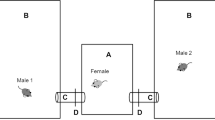Abstract
Females ofMus musculus domesticus from the inbred strains DBA/Ibg, C57BL/Ibg, C57BL/J, BALB/Ibg, and C3H/J were tested for mating preference choice between males from their own strain and males from another strain. A general consistency with previously reported results was found, in that the females preferred to associate and mate with males of the opposite strain. However, no preference was found in the case of two strains: BALB/Ibg and C3H/J. Also, C57BL/Ibg females, which generally displayed mating preference for the opposite strain, did not show any preference when allowed to choose between C57BL/Ibg and BALB/Ibg males. The possible effect of male differential attractiveness or sexual ability (sexual selection) on the determination of female mating preference is excluded since no strain of males had an advantage when “neutral” females from a heterogeneous strain were tested for mating preference. The male mating preference of the strains DBA/Ibg and BALB/Ibg was tested in a situation set up to reduce possible bias from the female's differential receptiveness. As in the previous experiment, the males did not seem to have any mating preference.
Similar content being viewed by others
References
Bastock, M. (1956). A gene mutation which changes a behavior pattern.Evolution 10: 421–439.
Lill, A. (1968). An analysis of sexual isolation in the domestic fowl: 1. The basis of homogamy in males.Behaviour 30: 107–126.
Mainardi, D. (1964). Relations between early experience and sexual preference in female mice (a progress report).Atti Ass. Genet. Ital. 9: 141–145.
Mainardi, D., Marsan, M., and Pasquall, A. (1965). Assenza di preferenze sessuli tra ceppi nel maschio diMus musculus domesticus.Inst. Lombardo (Rend. Sc.) B99: 26–34.
McClearn, G. E., Wilson, J. R., and Meredith, W. (1970). The use of isogenic and heterogenic mouse stocks in behavioral research. In Lindzey, G., and Thiessen, D. D. (eds.),Contributions to Behavior-Genetic Analysis: The Mouse as a Prototype, Appleton-Century-Crofts, New York, pp. 3–22.
McGill, T. E. (1962). Sexual behavior in three inbred strains of mice.Behaviour 19: 341–350.
Sturtevant, A. H. (1915). Experiments on sex recognition inDrosophila.J. Anim. Behav. 5: 351–356.
Yanai, J., and McClearn, G. E. (1972). Assortative mating in mice. I. Female mating preference.Behav. Genet. 2: 173–183.
Author information
Authors and Affiliations
Additional information
This work was supported by NIGMS Grant GM-14547.
Rights and permissions
About this article
Cite this article
Yanai, J., McClearn, G.E. Assortative mating in mice. II. Strain differences in female mating preference, male preference, and the question of possible sexual selection. Behav Genet 3, 65–74 (1973). https://doi.org/10.1007/BF01067690
Received:
Issue Date:
DOI: https://doi.org/10.1007/BF01067690




